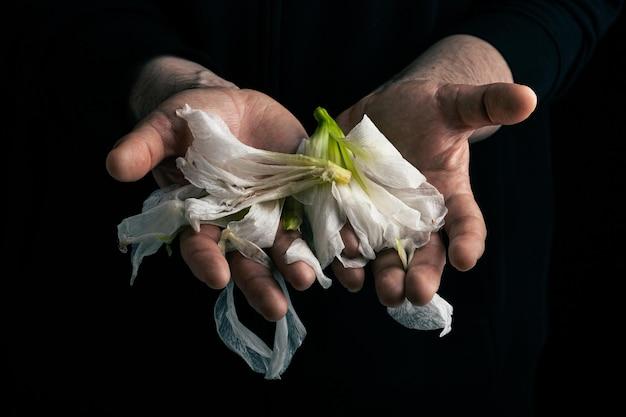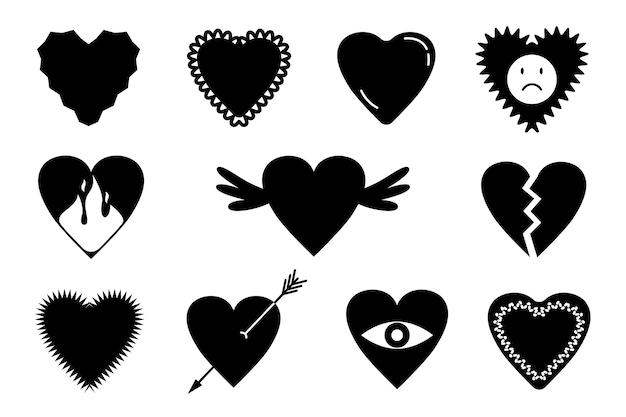From time immemorial, flowers have served as messengers of emotions, their delicate petals whispering sentiments too profound for words. In the realm of sadness and depression, certain flowers have emerged as enduring symbols, offering solace and a profound connection to our innermost struggles. Join us on a journey through the language of flowers, as we explore the meanings behind these beautiful blooms that speak to the depths of our hearts.
In this blog post, we will delve into the symbolism of various flowers associated with sadness and depression. We’ll uncover the hidden meanings behind blossoms like the marigold, the lilac, and the forget-me-not, and discover the profound emotions they represent. We’ll also explore the significance of color in expressing sorrow, and touch upon the connection between flowers and mental health. So, let us embrace the beauty and symbolism of flowers as we navigate the intricate landscape of sadness and find hope within its depths.
So, let us embark on this floral journey, where petals become words, and the language of flowers becomes a guide as we navigate the realm of sadness and depression. Together, let’s explore the profound symbolism that blooms amidst our darkest moments.

What Flower Represents Sadness and Depression?
Flowers have a unique way of expressing emotions, and just like a smile can brighten up a room, the right flower can bring comfort in times of sadness and depression. While there isn’t a single flower that represents sadness and depression exclusively, certain blooms convey a sense of sympathy and understanding that can be incredibly meaningful to someone going through a difficult time. Here are a few flowers that are often associated with emotions of sadness, sorrow, and reflection:
1. The Forget-Me-Not: A Reminder of Love and Memories
Forget-Me-Nots might seem like an odd choice for representing sadness, but hear me out. These delicate blue flowers symbolize remembrance and are often associated with lost loved ones. Their name, as quirky as it may sound, holds a powerful message of not forgetting those who have left us. By offering forget-me-nots to someone struggling with sadness, you’re telling them that their feelings and memories matter, and that their loved ones will always be remembered.
2. The Lily: Elegance and Grace Amidst Grief
The lily, with its serene beauty and delicate fragrance, is often associated with funerals and grieving. Commonly seen at memorial services, this flower’s symbolism encompasses the innocence of a departed soul and the renewal of life. The lily’s elegant petals and graceful form can provide solace and a gentle reminder that life goes on, even in times of sadness and despair.
3. The Hyacinth: Honoring Sorrow and Seeking Solace
Often linked with springtime, the hyacinth isn’t all about blooming fields and chirping birds. These fragrant flowers can also symbolize sorrow and asking for forgiveness. Offering hyacinths to someone facing depression can convey the message that you understand their pain and are there to offer support. Whether in vibrant hues or soft pastels, this bloom represents empathy and the hope of finding solace in difficult times.
4. The Iris: Reflection and Reassurance
With its striking and unique blooms, the iris is a flower that embodies various meanings across different cultures. In the language of flowers, the iris is associated with wisdom, hope, and faith. The petals’ various colors can represent different facets of emotions, including sadness and reflection. By gifting someone irises, you extend a heartfelt reminder of the strength that comes from introspection and self-discovery, even during periods of sadness.
5. The Snapdragon: A Whimsical Symbol of Graceful Strength
When it comes to the snapdragon, its name alone gives it a leg up in the humor department. But don’t dismiss this cheerful bloom just yet! Snapdragons symbolize strength and grace in the face of adversity. Their whimsical appearance, reminiscent of tiny dragon mouths, adds a touch of lightheartedness to their meaning. Presenting snapdragons to someone experiencing sadness and depression conveys the idea that they possess the inner strength to overcome their struggles and emerge victorious.
Depression and sadness can be challenging emotions to navigate, but by considering the symbolism of these flowers, we can offer emotional support and remind our loved ones that they are not alone. Remember, it’s not just about the flowers themselves, but the thought and care behind them that truly matters.
So, the next time you want to show someone going through a tough time that you’re there for them, consider the power of these flowers. Sometimes, the smallest gestures can have the most significant impact.

FAQ: What Flower Represents Sadness and Depression?
In this FAQ-style subsection, we’ll explore various flowers and colors that symbolize sadness and depression. Whether you’re curious about the meanings behind certain flowers or seeking solace in nature, this guide will provide you with the answers you need.
What Does Marigold Symbolize
Marigolds are notorious for their vibrant colors and positive symbolism. However, when it comes to representing sadness or depression, marigolds may not be the most fitting choice. These fiery flowers symbolize passion, creativity, and productivity, rather than melancholy emotions.
What Flower Symbolizes Regret
When it comes to regret, the delicate and graceful forget-me-nots take center stage. With their beautiful blue petals, these flowers symbolize remembrance, nostalgia, and loyalty. While they may not directly represent sadness, their association with memories can evoke emotions related to regret.
What Color Stands for Sadness
Blue is often associated with sadness, reflecting feelings of melancholy and introspection. It’s as if the color itself holds a melancholic symphony, echoing sentiments when words fall short. So, if you’re seeking a color that symbolizes sadness, blue is your canvas.
What Symbolizes a Broken Heart
While a broken heart can’t be healed by flowers alone, certain blooms carry symbolic meanings related to this profound emotional state. Roses, particularly the red ones, often associated with love, can also symbolize heartbreak. Their beauty juxtaposed with thorns represents the pain and vulnerability experienced in matters of the heart.
Does Blue Symbolize Sadness
Yes, blue symbolizes sadness, similar to the way the sky mirrors our emotions on a rainy day. The cool hue of blue captures the essence of sadness, providing a visual representation of the emotional depths one may feel.
What Does Lilac Symbolize
Lilacs, with their enchanting fragrance and delicate blooms, can represent various emotions, including love, youthfulness, and spirituality. However, their association with loss and mourning also makes them a flower that symbolizes sadness.
What Flower Is for Mental Health
When it comes to mental health, the beautiful chamomile flower offers solace. This unassuming bloom has been praised for its calming properties, which can help ease anxiety and promote a sense of tranquility. So, next time you’re feeling overwhelmed, a cup of chamomile tea might just be what you need.
What Flower Means Goodbye
If you’re searching for a flower that signifies farewell, the striking white lily stands proudly as a poignant symbol. With its pure color and graceful petals, the lily represents purity, innocence, and often serves as a flower of remembrance for loved ones who have passed away.
What Do Buttercups Symbolize
Buttercups, with their bright yellow petals, symbolize cheerfulness and joy. While they may not be directly associated with sadness or depression, their infectious and radiant charm can certainly uplift spirits and bring a smile to your face.
What Flowers Symbolize Loneliness
If you’re feeling lonely, certain flowers can offer comfort and companionship in their symbolic language. The delicate iris represents solitude, making it an ideal flower to acknowledge and embrace moments of introspection.
What Is the Symbol of Sadness
The symbol of sadness has no fixed form, but the weeping willow tree often represents profound sorrow and loss. With its cascading branches and teardrop-like leaves, this majestic tree captures the essence of mourning and melancholy.
What Flower Helps with Stress
When stress becomes overwhelming, lavender steps in as a natural remedy and symbol of tranquility. Its calming aroma and delicate purple blossoms can soothe the mind and promote relaxation, offering a respite from the demands of daily life.
What Flowers Have Negative Meanings
While most flowers carry positive associations, a few blooms hold negative connotations. The beautiful but deadly oleander, for example, symbolizes caution and danger. Similarly, the yellow carnation signifies disappointment and rejection. Despite their negative meanings, it’s essential to remember that every flower has its own unique beauty.
What Do Forget-Me-Nots Symbolize
Forget-me-nots carry a poignant message in their delicate petals. As their name suggests, they symbolize remembrance, eternal love, and a lasting connection. These charming blue flowers serve as a gentle reminder that some bonds are never truly broken.
What Color Represents Pain
The color that often represents pain is red. This intense hue symbolizes a range of emotions, including love, anger, and anguish. Red acts as a visual reminder of the raw, visceral nature of pain.
Is Purple a Sad Color
While purple may be associated with royalty and luxury, it does not typically symbolize sadness. However, emotions are subjective, and personal associations with colors can vary. If purple resonates with your feelings of sadness, then it can be your personal color of solace.
What Is Lotus Flower Meaning
The lotus flower holds profound symbolism, representing purity, enlightenment, and resilience. Despite growing in muddy waters, the lotus blossoms above the surface, symbolizing the ability to rise above adversity. While not directly associated with sadness or depression, the lotus offers inspiration and hope in challenging times.
What Does Lavender Symbolize
Lavender, with its soothing fragrance and calming properties, symbolizes serenity, grace, and devotion. Lavender’s tranquil essence makes it an ideal symbol for peace and a gentle reminder to find solace in simplicity.
Which Flower Symbolizes Evil
The pitch-black bat orchid is often associated with mystique and intrigue, sometimes even taking on an eerie aura associated with evil. With its distinctive appearance resembling bats in flight, this unique flower holds a mysterious appeal.
Is There a Symbol for Mental Health
The semicolon has become a symbol for mental health awareness and perseverance. Acting as a reminder that a story doesn’t end with a period, a semicolon signifies hope and the choice to keep writing one’s narrative. It serves as a visual representation of support and solidarity for those battling mental health challenges.
What Flower Symbolizes Heartbreak
Heartbreak finds resonance in the graceful petals of the bleeding heart flower. With its unique shape resembling a heart pierced by an arrow, this poignant bloom captures the essence of emotional pain and loss, serving as a symbol of heartbreak’s delicate beauty.
In this FAQ-style subsubsection, we’ve explored various flowers, colors, and symbols associated with sadness and depression. While flowers and colors can offer solace, it’s important to seek professional help when dealing with mental health challenges. Remember, nature’s beauty can serve as a gentle companion on the journey toward healing.